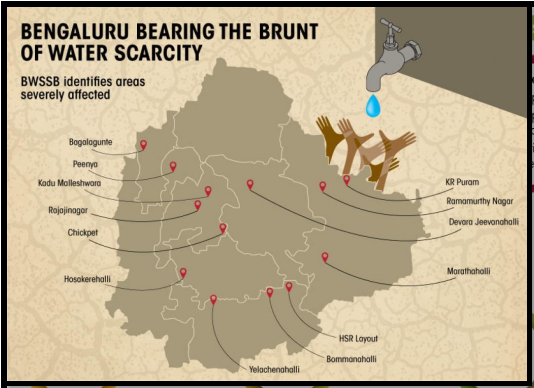“ADDRESSING BENGALURU’S WATER CRISIS: STRATEGIES FOR SUSTAINABLE URBAN WATER MANAGEMENT”
Syllabus:
- GS-3-Water woes of a city and its impact on various indicators of development
Focus :
- Top of Form
- The article delves into Bengaluru’s acute water crisis, exploring its underlying causes such as geographical challenges, urbanisation, and climate change. It proposes a comprehensive approach to address the crisis, including immediate demand management measures, medium-term structural solutions like rainwater harvesting and wastewater treatment, and long-term strategies for sustainable urban water management.
Source - DTE
Understanding the Water Crisis in Bengaluru
- Bengaluru’s acute water shortage has become a pressing issue, characterized by disrupted water supplies, soaring tanker prices, and strict usage restrictions.
- Geographical challenges, including the city’s high elevation and lack of natural freshwater sources, exacerbate the crisis.
- Over-extraction of groundwater, depletion of water bodies, and inadequate replenishment further contribute to the problem.
- Dependence on the Cauvery River for only half of the city’s water needs highlights the precarious situation.
- Erratic rainfall patterns, worsened by climate change, intensify the strain on water resources.
| Specific Terms :
Water Stress – India falls into the water stress group (less than 1700 cubic meters) with an annual per capita availability of 1,486 cubic meters in 2021. This might drop to 1,140 cubic meters by 2050 and 1,341 cubic meters by 2025, according to government forecasts. Water Crisis: Water crisis is defined by the World Bank as a situation in which the annual per-capita availability is less than 1000 cubic meters. SDG 6- Clean water and Sanitation |
Immediate Measures for Demand Management
- Local municipal bodiesmust lead demand management efforts through awareness campaigns and incentives for water conservation.
- Implementation of smart water meters and pressure managementsystems can aid in monitoring and reducing water consumption.
- Citizen engagement is crucial, with campaigns promotingbehavioral changes and adoption of water-saving technologies.
- Installation of water aerators and other plug-and-play solutionsat the household level can effectively reduce water wastage.
- Collaboration between municipalities and technologyproviders can facilitate the rapid deployment of demand management solutions.
Medium-Term Structural Solutions
- Rainwater harvesting initiatives should be expandedon a broader scale, including the implementation of percolation pits and storm drain management systems.
- Wastewater treatment infrastructuremust be improved to promote the reuse of treated water and reduce dependence on freshwater sources.
- Encouraging the use of tertiary treated water for non-potable purposescan help conserve freshwater resources.
- Innovative wastewater treatment technologies, such as decentralised modular systems, offer scalable solutions for urban areas.
- Pipeline management and regular maintenanceare essential for ensuring the efficiency and reliability of water distribution systems.
Long-Term Strategies for Sustainable Urban Water Management
- Cities should reduce their reliance on distant water sources by promoting sustainable urban planning and local water management practices.
- Conservation of lakes and propermanagement of borewells are critical for replenishing groundwater and ensuring water resilience.
- Sustainable development initiatives, including rainwater harvesting mandates and lake preservation efforts, should be integrated into urban planning frameworks.
- Investments in renewable energy and energy-efficient water supply systemscan reduce the environmental impact of water extraction and distribution.
- Collaborative efforts involving government agencies, researchinstitutions, startups, and civic groups are essential for implementing long-term solutions and building water-resilient cities.
Addressing Water Crises in Indian Cities
- Bengaluru’s water crisis serves as a wake-up call for other Indian cities facing similar challenges due to rapid urbanisation and climate change.
- Collaborative efforts involving multiple stakeholders are necessary to address water crises effectively and ensure sustainable water management practices.
- Innovative technologies and policy interventions can play a significant role in mitigating water stress and building resilience in urban areas.
- Long-term planning and investments in water infrastructure are essential for safeguarding water securityand meeting the growing demands of urban populations.
- Integrated approaches that combine demand management, structural solutions, and long-term strategies are key to addressing water crisesand ensuring water sustainability in Indian cities.
Associated articles :
- https://universalinstitutions.com/keep-water-at-the-centre/
- https://universalinstitutions.com/water-an-instrument-to-build-world-peace/
Source:The Hindu
Mains Practice Question :
GS-3
“Discuss the multifaceted nature of Bengaluru’s water crisis, highlighting the interplay of geographical challenges, urbanisation, and climate change.(250 words)
“Evaluate the effectiveness of immediate, medium-term, and long-term strategies for sustainable urban water management in addressing this crisis, and examine their applicability to other Indian cities facing similar challenges.” (250 words)




